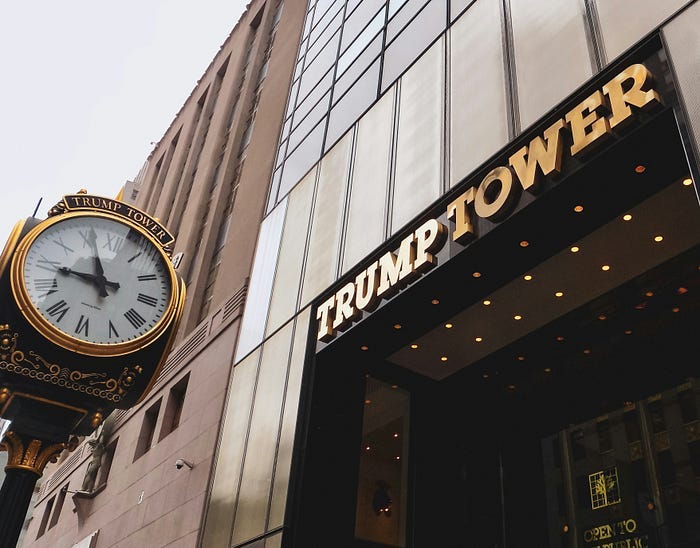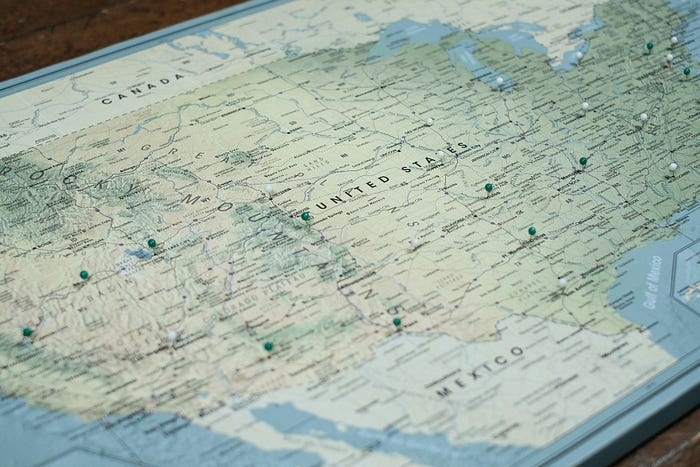America First: Trump’s Anti-Immigration Rhetoric
Let me tell you about something called the ‘lebensraum.’

The fact that Donald Trump has a history of racism is not breaking news.
It didn’t start with his election campaign in 2015; the Trump family has been promoting segregation and white supremacy from the beginning.
Trump’s father, Frederick Trump, was by all accounts a rather problematic figure — and I’m not talking about his alleged connections to the Klan, which are often cited around the internet but can’t be backed up by evidence.
Nevertheless, it’s not surprising that a white man born in 1905 harbored racist sentiments, and it shouldn’t be a shock to learn that he did his best to pass those views on to his children.
Donald’s views on hierarchies and race were inspired and encouraged by his father, and we know this because Fred Trump and Donald were both taken to court for systemic discrimination back in the 1970s, during the time that Donald was managing his father’s real estate company.
They didn’t let Black people rent apartments in buildings they owned. They didn’t want Black families living alongside white families, and they sought to enforce that segregation with the limited power that they had.
On top of that, the testimonies from his granddaughter about Frederick Trump’s treatment of his children paint quite a picture — and going by Donald’s own statements, Fred was a staunch believer in the idea that if you fail, you’re a loser and it’s always your own fault.
He had a very ‘might make right’ style of parenting. We see a lot of that kind of rhetoric being echoed by his son today.
Going by Donald Trump’s public behaviour, statements, and statements made by his nephew over the treatment of his disabled son, it’s clear that this attitude extends far beyond racism.
In Trump’s world, people have no intrinsic value as human beings. All that matters is whether they are useful to him or not.
The more marginalized, disabled, or poor you are, the less you matter and the more of a burden you are. If you aren’t an able-bodied, cisgender, straight white man of means, you’re not worth his time.
Unless you’re a physically attractive woman he can harass, of course. But that’s a whole other can of worms.
To break down Trump’s racist views, let’s begin with the concept of heirarchy.

The idea of a strict hierarchy of winners and losers is very much a hallmark of Trump’s campaign and his time in office.
In fact, it’s pretty much the hallmark of right-wing political theory; people belong in the socio-economic class they’re able to achieve, and if they can’t get further, it’s because they aren’t good enough. In their minds, systemic injustice is a made-up excuse and not a real reason for struggle.
As Ian Danskin says in the above link, for the disabled or poverty-stricken, support should be viewed as an optional gift that you should be deeply grateful for.
The idea that equity and cooperation ensure a good life for all people is just plain silly in their eyes. It’s a childish fantasy with no basis in reality because humans are fundamentally selfish.
You get what you work for, and if you can’t work, then you can reach out to charity and stop hoping for a better life.
Pull yourself up by your bootstraps or remain lying in the dirt where you fell. Nobody will offer you a hand up, so you should just try to be happy where you are.
They’re very much bogged down in a dog-eat-dog-world sort of mindset, where success is the benchmark for self-esteem. In this light, it makes sense that somebody like Donald Trump would be a popular figure on the extreme right-wing.
His talking points and ‘America First’ rhetoric appeal to both their personal values and also to the dogmatic nationalism that so many American Conservatives cling to.
There is a certain degree of tribalistic thinking baked into Conservative thought.
What’s important is your personal survival and the prosperity of your family. Outsiders are an extra expense or a potential threat; support for them is support that you aren’t getting, and that’s a problem.
This is in contrast with most people on the left, who tend to have a much more communal view of success. Society should be judged on how well its poorest are doing, and equity is a goal to strive for.
This is the fundamental disconnect between the Conservatives and Progressives, and it’s a large part of why Donald Trump is deeply unpopular outside of far-right circles.
Apart from the blatant discrimination, misogyny, and incompetence of course. Yes, I’m biased. I will not pretend otherwise.
The MAGA movement very much flows from this same vein. Unfortunately, if we look back through human history, we can see where this kind of thinking inevitably leads.
Yes. We need to talk about the MAGA movement and Nazi Germany.

Go ahead and call me out for that comparison, I’m used to it.
But seriously, denying the parallels between 1930s Germany and post-Trump America is the purview of the misinformed. The more you do the research, the more chilling the similarities become, and it’s not just me saying that.
Historians are on the exact same page.
When we think about Nazi Germany, we picture the Holocaust. Having toured the Holocaust Memorial Museum in Washington D.C., I get that impulse. It’s raw, visceral and heart-wrenching.
Read more about my visit here. It gutted me in a way that I struggle to express.
It’s tempting to look at that and dismiss any potential connection between German fascism and the political situation in North America today, but that would be a mistake.
When we compare Trump to Hitler, we’re not calling him a mass murderer. Not yet.
He’s certainly shown a disquieting callous disregard and outright hate toward minority groups, and that’s more than enough reason to say he shouldn’t be in office.
But what we’re actually saying is that there’s a disturbing degree of similarity between Hitler’s rise to power and the methods by which Donald Trump is attempting to secure unquestioned power.
We’re saying that he represents a threat to Democracy that must be taken seriously.
Trump’s January 6 was his version of the Beer Hall Putsch. The biggest mistake you could make is to give him a chance to try again. America made that mistake half a year ago.
And here we are, watching him dismantle the government and Constitution he swore to protect.
But don’t mistake me; the racism isn’t just his personal opinion coming to the surface. It’s a tactic.
Trump’s anti-immigration rhetoric has been a big part of his campaign from the start, it remains a huge part of his Presidency, and he’s using it in much the same way that fascists have always done; a way to invent an enemy and stoke division and slavish loyalty.
His constant chatter about mass deportation sounds very familiar to me, as I’m sure it does to anyone else who studies history.
To explain why it’s a problem — if you need it explained, for some reason — let me tell you about Lebensraum.

Lebensraum is a German word that translates to ‘living space.’
This was the idea that the German people — the ‘Aryan people’, specifically — had a natural right to world dominance. The idea pre-dates Hitler by quite a while, but he certainly took the notion and ran with it.
Aryan superiority and territorial dominance were a key part of Hitler’s political platform, and it formed the foundation of Nazi Germany’s expansion and annexation of its surrounding nations through the war.
Hitler made frequent comparisons to America’s policy of Manifest Destiny and had a habit of idolizing and glorifying the eugenics-based policies of segregation and extermination in American history.
We know for example that Madison Grant, the author of the outrageously racist book, ‘The Passing of the Great Race’ once recieved a fan letter from a young Adolf Hitler, who praised the book as ‘my Bible.’
To ensure the survival of the ‘Aryan race’, he thought that it was necessary to take control of new lands and force the local inhabitants out. Resettlement and mass deportation were a part of this plan.
The idea was that Germany needed to use its resources only to benefit its own people. Anyone else within Germany’s borders was just a leech. A burden.
Inferior vermin that needed to go.
Hitler very often made references to non-Aryan people — especially Jewish and Slavic people — as parasites. The Nazis often distributed propaganda that made bold claims about ‘restoring order’ by getting rid of non-Aryan people who supposedly posed a threat to law-abiding German citizens.
Does this sound familiar yet?
Are you maybe getting a little bit uncomfortable with the kind of language that was used back then and how blatantly similar it is to far-right rhetoric today?
Let’s take it a step further; let’s talk about some public statements by Donald Trump at his rallies during the 2024 Presidential race.
We’ll even skip over the old ones, like the time he launched his original campaign by saying Mexico was sending drugs, crime, and rapists.
Sorry, I feel like that one doesn’t get repeated enough.

At his rally in Wisconsin, Trump repeated a thoroughly debunked claim that migrants were ‘taking over’ parts of Colorado. He added that getting them out would be a ‘bloody story.’
He has repeatedly and falsely claimed that there are between 15 and 20 million undocumented immigrants in the United States, and he plans to target all of them with mass deportation.
He has claimed that the migrants coming over the Southern border are coming from jails and insane asylums, calling them a grave threat to the safety and security of law-abiding American citizens.
I suspect his claims about them coming from insane asylums might come down to Trump having no clue what ‘asylum seeker’ means.
He’s said they’re bringing disease, and then there’s the ‘poisoning the blood of our country’ comment, just to hammer the point home.
He’s railed against the ‘radical left’ and how we’re awful for calling him out for dehumanizing migrants, who he has referred to as animals.
“I don’t know if you’d call them people, in some cases they’re not people in my opinion but I’m not allowed to say that.” — Former President Donald Trump, at his rally in Ohio.
Over and over again, the exact same Othering rhetoric pops up. He is stoking fear and revulsion towards immigrants and asylum seekers to drum up loyalty among his supporters.
As long as his loyalists have an enemy to fight against, he can secure their support by promising to do something about it. This is one of the 14 characteristics of fascism that we talked about if you’re keeping count.
Rigid adherence to gender roles and disdain for people who break out of the strict gender or sexual binary are also on the list, by the way.
Which he’s also throwing out there to get attention, alongside the entire Republican party. The day-one targeting and dismissal of trans and non-binary identities was part of this strategy.
Trump’s platform has always been based on division and hatred of minority groups and political opponents.
He rails against marginalized communities, treats immigrants as a threat, and uses racial identity as his rallying cry to attack his current opponent in the electoral race.
He — like all fascists before him — panders to a mythical, glorious past that his nation could rebuild, but only if they give him the reins and let him do what he wants.
Just look at a few of his favorite slogans:
America First
Make America Great Again
Build That Wall
Lock Her Up
He has built a fanatical cult around him that is willing to attack the foundations of the nation they claim to love. Self-described patriots who don’t know what the word means.
Trump’s anti-immigration rhetoric is not new, and it isn’t surprising. But it is serious, and we shouldn’t shrug it off.
We saw what he did with it last time. Now that he’s been given a second chance, there’s no telling how bad things are going to get.
Solidarity wins.

